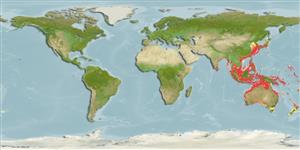>
Eupercaria/misc (Various families in series Eupercaria) >
Haemulidae (Grunts) > Haemulinae
Etymology: Pomadasys: Greek, poma, -atos = cover, operculum + Greek, dasys = with hair (Ref. 45335).
More on author: Cuvier.
Environment: milieu / climate zone / depth range / distribution range
Ecología
marino; salobre bentopelágico. Tropical
Distribución
Países | Áreas FAO | Ecosistemas | Ocurrencias, apariciones | Point map | Introducciones | Faunafri
Western Pacific: China, Thailand, Singapore, Malaysia, and New South Wales, Australia.
Tamaño / Peso / Age
Maturity: Lm ? range ? - ? cm
Max length : 52.0 cm TL macho / no sexado; (Ref. 47695); common length : 43.0 cm TL macho / no sexado; (Ref. 47695)
Espinas dorsales (total): 12; Radios blandos dorsales (total): 14; Espinas anales 3; Radios blandos anales: 7. Body color silvery to light burnished gold; dorsal fins with well defined blackish spots on interspinous membranes; adults with blackish spot on tip of each scale on back and upper sides. Body depth 3.2 tomes in SL. Head large; upper profile convex; gill cover and angle of preopercle lengthened as convex rounded lobe; gill cover extending to above 1/3 to 1/2 of pectoral fins. Mouth small; maxilla reaching to eye. Pores 2 and a median pit on chin (Ref. 47695).
A rare species apparently inhabiting deeper waters of the continental shelf (Ref. 47695).
Life cycle and mating behavior
Madurez | Reproducción | Puesta | Huevos | Fecundidad | Larva
Oviparous, distinct pairing during breeding (Ref. 205).
McKay, R.J., 2001. Haemulidae (=Pomadasyidae). Grunts (also sweetlips, hotlips, and velvetchins). p. 2961-2989. In K.E. Carpenter and V.H. Niem (eds.) FAO species identification guide for fishery purposes. The living marine resources of the Western Central Pacific. Volume 5. Bony fishes part 3 (Menidae to Pomacentridae). Rome, FAO. pp. 2791-3380. (Ref. 47695)
IUCN Red List Status (Ref. 130435)
Threat to humans
Harmless
Human uses
Más información
ReferenciasAcuiculturaPerfil de acuiculturaRazasGenéticaElectrophoresesheritabilidadEnfermedadesProcesamientoNutrientsMass conversion
ColaboradoresImágenesStamps, Coins Misc.SonidosCiguateraVelocidadTipo de nataciónSuperficie branquialOtolitosCerebrosVisión
Herramientas
Special reports
Download XML
Fuentes de Internet
Estimates based on models
Preferred temperature (Ref.
123201): 16.3 - 28.3, mean 26.5 °C (based on 946 cells).
Phylogenetic diversity index (Ref.
82804): PD
50 = 0.5000 [Uniqueness, from 0.5 = low to 2.0 = high].
Bayesian length-weight: a=0.01738 (0.00807 - 0.03743), b=3.02 (2.83 - 3.21), in cm total length, based on LWR estimates for this (Sub)family-body shape (Ref.
93245).
Nivel trófico (Ref.
69278): 3.5 ±0.4 se; based on size and trophs of closest relatives
Resiliencia (Ref.
120179): Medio, población duplicada en un tiempo mínimo de 1.4-4.4 años (Preliminary K or Fecundity.).
Fishing Vulnerability (Ref.
59153): Moderate vulnerability (41 of 100).
